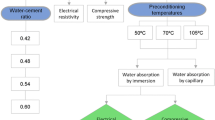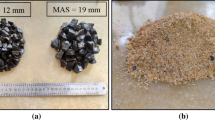Abstract
The pore structure of concrete is known to be of high importance for the durability of the material. A characterisation of this pore structure by means of a simple test is often investigated, in order to find a very simple compliance criterion with respect to concrete durability. Within some daily-used Belgian technical guidelines, the water absorption by immersion is considered to be a relevant parameter in this respect. Based on an extended experimental research programme, with test on 22 different concrete mixes (traditional concrete and self-compacting concrete), the relation between water absorption by immersion and some concrete durability issues is investigated. Within these tests, accelerated carbonation and chloride migration tests are realised. Furthermore, some technological parameters are investigated, related with the volume to surface ratio of the specimens used for the water absorption test. It is concluded that the influence of the volume-to-surface ratio of the specimens is not significant when considering the natural scatter on the test results. Furthermore, the water absorption by immersion is not a reliable parameter for the estimation of the concrete durability. The water absorption by immersion gives an estimation of the total (reachable) pore volume of the concrete, but gives no indication on the concrete permeability, which is more important with regard to durability.
Résumé
Il est bien connu que la durabilité du béton est corrélée avec les caractéristiques de la structure des pores. Beaucoup de recherches ont déjà été faites concernant la caractérisation de cette structure à l'aide d'un essai simple, et ceci, afin de trouver un critère d'acceptation simple garantissant la durabilité. Parfois, l'absorption d'eau par immersion est considérée comme un paramètre important dans ce contexte. À l'aide d'un programme expérimental de recherche sur 22 compositions différentes (comprenant béton traditionnel et béton autoplaçant) la relation entre l'absorption d'eau par immersion et deux aspects de la durabilité du béton a été étudiée. Le programme expérimental inclut des essais accélérés de carbonatation et de pénétration de chlorures. En plus, quelques paramètres technologiques ont été examinés, comme le rapport entre le volume et la surface des échantillons. De ces essais, il est conclu que le rapport volume/surface n'est pas un paramètre signifiant, tenu compte de la variabilité des résultats individuels. De plus, l'absorption d'eau par immersion n'est pas un paramètre fiable pour l'estimation de la résistance contre la carbonatation et la migration de chlorures. L'absorption d'eau par immersion donne une idée globale de la porosité totale du béton. Malheureusement, l'absorption d'eau par immersion n'est pas fortement corrélée avec la perméabilité; celle-ci est un paramètre plus important pour la durabilité.
Similar content being viewed by others
References
Ye, G., ‘Experimental study and numerical simulation of the development of the microstructure and permeability of cementitious materials’, doctoral thesis, TU Delft, 2003.
Boel, V., Audenaert, K. and De Schutter, G., ‘Pore structure of self-compacting concrete’, First North American Conference on the Design and Use of Self-Consolidating Concrete, Evanston, 12–13 November 2002, 15–20.
Kropp, J. and Hilsdorf, H.K. (eds.), ‘Performance criteria for concrete durability’, in RILEM Report 12 (E&FN Spon, London, 1995).
Hilsdorf, H.K., ‘Durability of concrete— a measurable quantity?’, IABSE Symposium ‘Durability of structures’, Lisbon, 1989, 111–123.
Wirquin, E., Hadjieva-Zaharieva, R. and Buyle-Bodin, F., ‘Use of water absorption by concrete as a criterion of the durability of concrete— application to recycled aggregate concrete’,Mater. Struct. 33 (July 2000) 403–408.
Balayssac, J.-P., Detriche, Ch.-H. and Grandet, J., ‘Validity of the water-absorption test for characterizing cover concrete’,Mater. Struct. 26 (May 1993) 226–230.
De Souza, S.J., Hooton, R.D. and Grandet, J., ‘A field test for evaluating high performance concrete cover quality’,Can. J. Civ. Eng.,25 (1998) 551–556.
de Hainaut, K., ‘Inventarisation of damage to concrete structures’ (in Dutch), Master's thesis, Magnel Laboratory for Concrete Research, Ghent University, Belgium, 2001.
Luping, T. and Nilsson, L.-O., ‘Rapid determination of chloride diffusivity of concrete by applying an electric field’,ACI Materials Journal (1992) 49–53.
Luping, T. and Nilsson, L.-O., ‘Ionic migration and its relation to diffusion’, in ‘Ionic and Mass Transport in Cement Based Materials’, The American Ceramics Society, 2001, 81–96.
De Schutter, G., ‘Quantification of the influence of cracks in concrete structures on carbonation and chloride penetration’,Magazine of Concrete Research 51 (6) (Dec. 1999) 427–435.
Maekawa, K. and Ishida, T., ‘Service-life evaluation of reinforced concrete under coupled forces and environmental actions’, in ‘Ionic and Mass Transport in Cement Based Materials’, The American Ceramics Society, 2001, 219–238.
Neville, A.M., ‘Maintenance and durability of structures’,Concrete International (Nov. 1997) 52–56.
Lamond, J.F., ‘Designing for durability’,Concrete International (Nov. 1997) 34–36.
Author information
Authors and Affiliations
Additional information
Editorial Note Prof. Dr. Ir. Geert De Schutter is a RILEM Senior Member. He is the Chairman of RILEM TC DSC ‘Durability of self-compacting concrete’ and also participates in RILEM TCs 195-DTD ‘Recommendation for test methods for autogenous deformation and thermal dilation of early age concrete’, 188-CSC ‘Casting of self-compacting concrete’ and 196-ICC ‘Internal curing of concretes’. He was awarded the Robert L'Hermite Medal in 2001.
Rights and permissions
About this article
Cite this article
De Schutter, G., Audenaert, K. Evaluation of water absorption of concrete as a measure for resistance against carbonation and chloride migration. Mat. Struct. 37, 591–596 (2004). https://doi.org/10.1007/BF02483288
Received:
Accepted:
Issue Date:
DOI: https://doi.org/10.1007/BF02483288




